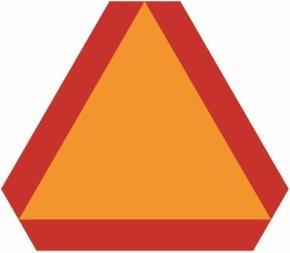The Ontario Highway Traffic Act (HTA) outlines the rules of the road for all drivers in Ontario and it includes rules and requirements for farm vehicles and farm implements being towed on roadways. Below you will find a summary of the HTA rules and requirements for farm vehicles and equipment.
Slow-Moving Vehicle (SMV) Signs

All farm equipment driven on a roadway, regardless if it is capable of road speeds over 40 km/h, must obey the 40 km/h speed limit and must display a SMV sign at the rear of the vehicle or object being towed. Every farm tractor or self-propelled implement on a roadway must display a SMV sign centred on the rear of the vehicle, 0.6 to 2 metres above the road.
The HTA section 76 (4) states “[n]o person shall place a slow-moving vehicle sign on or near a fixed object where it is readily visible from a highway”. It is against the law to use a slow-moving vehicle sign on fixed objects like mailboxes or driveway markers if they can be seen from the road. The purpose of SMV signs is to make other road users aware of vehicles that are moving slower than normal traffic and to reduce their speed.
It is also important to replace faded SMV signs and ensure they are clearly visible from 150 metres. When a farm vehicle or implement is loaded on a truck or trailer, remember the vehicle or implement is no longer considered a SMV and to remove or cover any SMV sign.
Driver's Licenses
You do not need a driver’s license to operate a farm tractor or self-propelled implement of husbandry (SPIH) along a road, but you must be at least 16 years old. Children younger than 16 can only drive farm vehicles directly across a roadway. A driver with an impaired driver’s license suspension cannot drive farm machinery on a road.
Where to Drive
Although it is legal to drive farm equipment on some road shoulders, you should drive on the travelled portion of the road. The shoulder may not be able to support the weight of your farm equipment and there may be obstacles on the shoulder. Farm equipment is also exempt from HTA vehicle width rules, but you must yield half the roadway to oncoming vehicles. If you leave your lane to travel on the shoulder, you must yield to any traffic in the roadway before re-entry.
Lights
Farm vehicles on a road between a half hour before sunset and a half hour after sunrise, or when vehicles are not clearly visible from 150 metres, must have at least two white headlights facing forward, and one red taillight facing rearward. When towing implements, the rear-most unit must have at least one red taillight. Farm vehicles or towed equipment over 2.6 metres wide must have two taillights, and over width equipment have other specific requirements outlined in the HTA.
Farm implement or combinations over 6.1 metres long need side marker lights; two green or amber lights at the front and two red lights at the rear; clearly visible from 150 metres.
Safety Chains
The HTA requires farm wagons and implements drawn along a roadway behind a farm tractor, SPIH, pickup or car to have two separate means of attachment, so if one fails the towed implement will not separate from the towing vehicle. The draw bar/hitch provides the first means of attachment; a safety chain/cable the second. A single safety chain is the most common way to meet this requirement. A safety chain must be strong enough to hold the weight of towed implements plus their loads. When towing multiple implements, each draw bar/hitch combination must have its own safety chain.
A three-point hitch does not require a secondary means of attachment. Two chains, crossed under the draw bar is a requirement only for heavy truck trailers. See the MTO Farm Guide for chain strength tables.
Self-Propelled Implements of Husbandry (SPIH)
SPIHs are vehicles manufactured, designed, redesigned, converted, or reconstructed for a specific use in farming. When converted from former road vehicles, an SPIH must exhibit significant outward, physical change to the cargo-carrying portion of the vehicle. The modifications should enable it to perform its specific farm use and not its previous function.
SPIH can travel on a road without license plates only if travelling from a farm to farm, to perform a farm use, or to or from places for maintenance or repairs. All other uses, including farm to commercial elevator or processing plant, require plates.
 Skip to main content
Skip to main content
